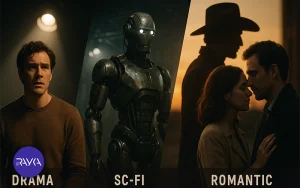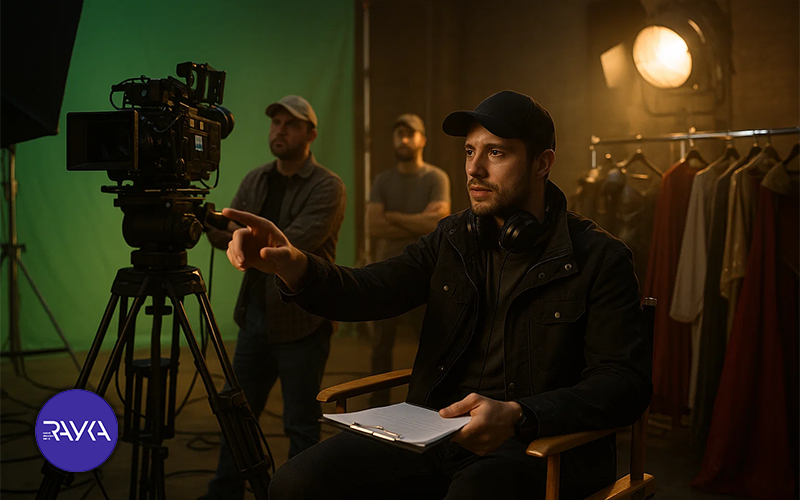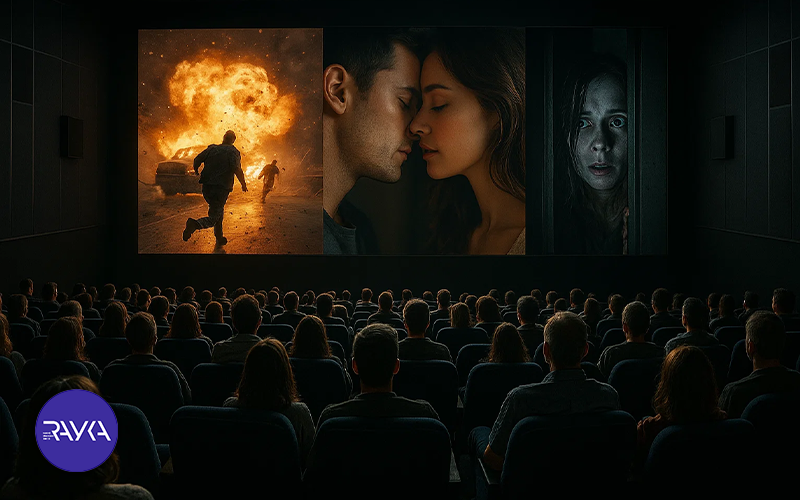
Today, cinema and film have become one of the most powerful forms of artistic, cultural, and entertainment expression. The term “film genre” helps you understand exactly what type of movie you are watching, what story is being told, the overall atmosphere, the roles of the characters, and what to expect from your viewing experience.
Understanding film genres is important not only for audiences to make smarter viewing choices but also for filmmakers and content creators, as it allows them to craft their work with purpose and better connect with the audience.
In this article, we first review the concept of a “film” and then explore film genres, their types, differences from cinematic styles, and the concept of sub-genres.
A film is a visual art form that combines images, sound, and motion to convey a story or emotion to the audience.
Film is one of the most important artistic and entertainment media in the world. By using a combination of visual and audio elements such as framing, lighting, music, and editing, it creates an emotional or intellectual experience for viewers. Films can be fictional, factual, educational, or a mix of these, and they play a key role in shaping culture and conveying social concepts.
Throughout history, cinema has evolved from a simple tool for displaying moving images into a powerful medium for human and global storytelling, blurring the lines between art and technology.
The history of film dates back to the late 19th century with inventions such as the motion picture camera and moving images.
Cinema began in the 1890s, when European and American inventors were experimenting with ways to make images move. The Lumière brothers held the first public film screening in Paris in 1895, marking the birth of cinema as an independent art form.
In the following decades, cinema underwent major transformations with the introduction of sound (1920s), color (1930s), and special effects. In the 20th century, major Hollywood studios and European film movements such as Neorealism and the New Wave shaped the evolution of this art. Today, thanks to digital technology and artificial intelligence, cinema has become a global, multidimensional medium, blurring the lines between reality and imagination.
Making a film is the result of collaboration among specialists, each playing a crucial role in shaping the final work.
Film production is a team effort, from idea development to final editing, involving many professionals. Here are the most important film crew roles:

A film genre refers to the categorization of movies based on similarities in theme, setting, style, and overall mood.
Film genre is one of the fundamental concepts in cinema, grouping films with shared characteristics. These characteristics may include the type of story, emotional tone, setting, narrative structure, or even the audience reaction a film aims to evoke.
Genres are not fixed; they evolve over time, blend with one another, and give rise to new subgenres. For example, combining science fiction with action has produced films like Inception and The Matrix.
Understanding genre is crucial for content creators, writers, and filmmakers, as it helps identify the target audience and enhance the emotional impact of a film.
Movies and TV series are categorized into different genres based on their content and predominant mood, with each genre having distinct features, target audiences, and goals.
Genres help viewers understand what kind of story to expect, while providing creators a framework to set the tone and structure of the narrative. Below, we introduce some of the most popular and well-known film and TV genres.
The social genre reflects the realities of people’s lives and the concerns of society.
Films in this genre often address issues such as poverty, justice, discrimination, migration, freedom, and human relationships. The main goal is to portray real societal problems and evoke empathy and awareness in the audience. Directors aim to depict everyday life and human challenges with a critical and realistic perspective.
Successful examples in Iranian cinema include “A Separation,” “Metri Shish o Nim,” and “Life and a Day,” which, through their emotional and human-centered narratives, have impacted both domestic and international audiences.
Some features are commonly seen in most works of this genre, though their intensity or style may vary depending on the director. The key characteristics include:
The tragedy genre tells stories of loss, failure, or emotional crises.
Tragic films depict deep, painful human emotions and, through sorrowful or tragic events, invite the audience to reflect and empathize. These films often have open or impactful endings that convey the harsh realities of life. Proper lighting plays a crucial role in this genre; the choice of brightness, shadows, and color can amplify feelings of sadness, loneliness, or anxiety in characters and enhance the emotional impact of scenes. Key features of this genre include:
The family genre presents entertaining and educational stories suitable for all members of the family.
Family films create a warm and friendly atmosphere, sharing moments full of joy, friendship, and human values with the audience. This genre typically features simple stories, likable characters, and positive messages, providing a safe and enjoyable experience for everyone. It is also used to convey moral lessons and teach life skills in an engaging and fun way.
The family genre has key features that make these films suitable for group viewing and shared enjoyment. The most important characteristics include:
The comedy genre creates humor and funny characters to make the audience laugh and entertain them.
Comedy films establish a light and cheerful atmosphere, allowing viewers to escape daily concerns. This genre uses unexpected situations, witty dialogues, and exaggerated characters to convey joy and amusement. Comedy can also blend with other genres, such as romance or fantasy, offering a diverse and engaging experience.
The defining features of comedy show which humorous and creative elements make the film enjoyable and fun for the audience. Key characteristics include:
The science fiction (sci-fi) genre presents exciting stories about technology, the future, and unknown worlds.
Sci-fi films transport the audience beyond reality, featuring space travel, artificial intelligence, robots, and alien civilizations. Beyond entertainment, this genre raises philosophical and ethical questions about humanity and technology, encouraging reflection and imagination. Special effects, creative sets, and innovative ideas create a unique and engaging experience. Key elements that distinguish sci-fi from other genres and make it thrilling for the audience include:

The musical genre tells a story through music and dance in a lively and exciting way.
Musical films immerse the audience in an energetic and joyful atmosphere. Singing, dancing, and music are integral to the narrative and help advance the story. This genre creates an entertaining and emotional experience, enhancing positive feelings and excitement, and leaving memorable moments for the viewer.
Key elements that make musicals engaging and exciting by blending music, performance, and storytelling include:
Film style refers to the way a movie is narrated, its visual design, and its artistic expression, and it is different from genre.
A cinematic style reflects the director’s approach and vision in creating the work. It encompasses visual choices, lighting, editing rhythm, color palette, framing, and even acting methods. In other words, style shows how a story is told and the mood it conveys, while genre focuses more on the type of story and the emotional experience for the audience.
For example, a romantic story (genre) can be presented in different styles such as poetic realism, Italian neorealism, or French New Wave, each providing a unique experience of the same narrative.
Genre defines the type of story and the emotional experience of the audience, while style refers to how the story is told and the visual expression of the film.
Both genre and style are important elements in cinema, but each plays a different role. Genre tells you what the film is about and what feeling it conveys, whereas style shows how the film is narrated and the overall mood it creates. The table below examines these differences in a simple and easy-to-understand way:
| Feature | Genre | Cinematic Style |
|---|---|---|
| Definition & Focus | Focuses on the type of story and emotional content | Focuses on how the story is told, world-building, and visual expression |
| Audience Experience | Determines what emotions the audience will feel | Shapes the visual and spatial experience of the film |
| Flexibility | A genre can be produced in different styles | A style can be applied across different genres |
| Key Elements | Theme, tone, characters, and plot events | Lighting, framing, color, editing rhythm, and actors’ performance |
| Purpose | Prepares the audience for the type of story | Shapes the feeling and visual experience of the story |
A subgenre is a smaller branch of a film genre that divides the story and style into more specific details, shaping the audience’s experience more precisely.
Each main genre can have multiple subgenres, offering different features, tones, and themes. For example, the science fiction genre can include subgenres like space opera or cyberpunk, and the comedy genre may have subgenres such as romantic comedy or dark comedy. Subgenres allow filmmakers to tell stories with more detail and focused emphasis, helping the audience know exactly what kind of experience to expect.
Artificial intelligence, by analyzing visual, audio, and textual data of a film, can recognize its genre and identify key characteristics of each genre, including tone, style, and story elements. Beyond identification, with advanced algorithms and content generation models, AI can produce films or short teasers designed according to a specific genre, effectively conveying the intended emotional experience to the audience.
This capability allows content production to be faster, more targeted, and more precise, enabling the creation of diverse projects across different genres.
With extensive experience in artificial intelligence and video content production, Raykamah can create feature films and professional teasers across various genres. Using advanced algorithms, the institute can identify a film’s genre and generate story elements, characters, music, and scenes in a coordinated manner, delivering a professional and engaging experience for the audience.
With Raykamah, film production is no longer limited to traditional methods; AI accelerates the filmmaking process and enables the creation of diverse content across multiple genres. This capability helps filmmakers design and execute creative, precise projects tailored to audience needs.
Film genres play a crucial role in shaping the audience’s experience, and with subgenres, diverse styles, and precise analysis, cinematic content can be made purposeful and engaging. Today, artificial intelligence has the capability to identify genres and even produce short films and cinematic teasers. Institutes like Raykamah, leveraging this technology, can create professional and diverse projects across various genres, delivering an engaging experience for the audience.